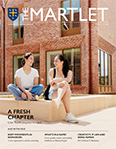A Tale of two galleries
 Dr Caroline Campbell (1991, History) has been Director of Collections and Research at the National Gallery, London since 2018. Previously she worked as a curator at the Ashmolean Museum, the Courtauld Gallery and the National Gallery, where she was the Jacob Rothschild Head of the Curatorial Department.
Dr Caroline Campbell (1991, History) has been Director of Collections and Research at the National Gallery, London since 2018. Previously she worked as a curator at the Ashmolean Museum, the Courtauld Gallery and the National Gallery, where she was the Jacob Rothschild Head of the Curatorial Department.
Dr Alexander (Xa) Sturgis (1982, History) has been Director of the Ashmolean Museum of Art and Archaeology since 2014, and was previously the Director of the Holburne Museum, Bath. Whilst at the Holburne Dr Sturgis oversaw a renovation of the Museum that included a £13 million extension. Before 2005, Dr Sturgis worked at the National Gallery, London, for 15 years, in various posts including Exhibitions and Programmes Curator from 1999–2005.
How do you go about reopening museums in these strange times?
Caroline: Visitors to the National Gallery are mostly tourists, so we’re going to have to work with our hyper local audience at least until a vaccine is found. Even then I don’t think travel is going to start back up to London to the same extent. It’s going to be interesting to see how the city develops, especially with Brexit. It’s a moment for being strong about what we are at the National Gallery.
Xa: At the moment because of social distancing we’re having to restrict. We know the population of Oxford and we have a million visitors a year. So, our visitors are clearly not just from Oxford and will never be solely from Oxford. The difficulty for museums is that funding has been reducing for decades. Suddenly, the whole business model driven by big loan exhibitions looks very precarious. It’s how we bring both new audiences in and old audiences back. It’s fantastic that we managed to hold onto Rembrandt but it’s going to lose a huge amount of money.
 Do we need to consider different ways of doing exhibitions?
Do we need to consider different ways of doing exhibitions?
Caroline: Yes. The beauty of an exhibition is that it provides that focus: the sense that there needs to be a reason you have to come to a museum now rather than in two years’ time. There have been all sorts of ideas about how permanent collections can be used to do that, which saves money. So far, unfortunately, none of them have been tremendously successful.
Xa: We’re hearing from our visitors to Rembrandt that they’re loving that they can go without scrums of people. I think the need to get as many visitors in shows as possible to make them economically viable can make the experience unrewarding, but I am worried about the idea that the empty museum is the perfect museum. The current visitors are inevitably loyal, regular visitors. We need to remember that that is not the only constituency we serve.
Caroline: Absolutely. Because if we do just that it’s going to also increase elitism. The perfect thing about museums ought to be that combination of objects and people. We’re all enjoying seeing exhibitions without hordes of people. But museums are places for people.
How are you approaching virtual experiences?
Xa: The digital seems to be the answer to all the challenges that museums face: accessibility of collections and how we interpret collections on-site to provide what every visitor wants in relation to interpreting the object. But, try to find a museum that has succeeded doing that! It’s not about using the tools to replicate an experience but about doing something completely different.
Caroline: I don’t think we can ever replace the physical sense of being with something. For some reason, it makes the hair on the back of your neck stand up. You can experience a lot from digital. But I think we’re kidding ourselves if we think it is the same. Museums have got to be doing both. One thing that really does excite me about the digital is that it can help the National Gallery do more outside of London. The National Gallery can, should and will be showing its collection more outside London, so that it really begins to seem truly a national gallery, not just a national gallery if you happen to visit Trafalgar Square.
 How do we go about putting collections online?
How do we go about putting collections online?
Xa: This is a great and daunting challenge for those of us with huge collections (unlike the National Gallery which only has a couple of thousand paintings compared to the Ashmolean’s million or so objects). Every great museum is also a research institution and a teaching institution and quite rightly is expected to make its collections available online, but we are being asked to create entirely new museums in the digital sphere without additional resources.
Caroline: The National Gallery has a small collection but the complexity of the information it holds is unbelievable. I’m working on a programme to make that information, which has been kept for 200 years in hundreds of sources, accessible to people and connected to our partner museums. We have to democratise our collections. Letting go is a powerful thing.
How do curators feel about letting go?
Xa: There is big excitement in certain quarters and less in others. The Ashmolean has one of the world’s great coin collections. For the past few years, the coin collections of the world have been linking their data and making it openly available, so that others can mine it in exciting ways to learn about the movement of people, money, goods and, even, ideas.
Caroline: There is the most resistance to linked open data in fine art because it is the most financially valuable part of most collections. Museums make money through licensing. If we’re thinking about finding ways in which we can still raise income when our whole model is changing, it is difficult to give up licensing as well..
How do you find a balance?
Xa: I feel strongly that the collections are not ours but belong to the public. But, in the absence of other ways of financing ourselves, which institution would wilfully cut off an arm? The institutions that made their collections freely available have done so thanks to huge funding. A balance needs to be struck.
Caroline: In a sense, we should be celebrating the fact that people love objects so much that they want to reproduce them. After all, imitation is the most sincere form of flattery. Ideally, we wouldn’t need income from licencing. But if we can’t bring in the money to support our work, where can we go?
 How can we broaden audiences?
How can we broaden audiences?
Caroline: One of my most powerful experiences of being a curator was working with Hull for three years on a 13th century Italian painting they bought to celebrate being named the UK Capital of Culture, which interacted a lot with schools. We spent a lot of last year developing a touring model for one of our most important recent acquisitions: Artemesia Gentileschi’s Portrait of Saint Catherine. It didn’t go to many places, but we worked with the places (a doctor’s surgery, a girl’s school, a prison, and a women’s library) for a long time.
Xa: The Ashmolean is very focused on introducing different voices and challenging Eurocentrism. We are working a lot now with community ambassadors who help us think about our collections from completely different perspectives and in completely different ways. These are collections for use in the ways that are most useful to the public that we serve. All of us who work in museums do so because at some point in our lives we have been inspired if not transformed by an encounter with an object or work of art in a museum. It is a fundamental duty for those of us who work in museums to open that door for people who are not naturally going to be brought into museums. Unless that door is opened, people aren’t going to be able to get through it.
What was your moment?
Xa: I’m ashamed to say it was with a Renoir painting as a child.
Caroline: Don’t be ashamed! I think mine was going to Edinburgh as a teenager in the National Gallery of Scotland. I was completely dazzled by the two Titian “poesie.” I watched as the pictures changed with the light and they suddenly seemed like living things. This year we gathered the Titian “poesie” together in the National Gallery for the first time since the 16th century. Collections aren’t static. They’re dynamic!
This feature was adapted from one first published in Issue 12 of The Martlet; read the full magazine here or explore our full back catalogue of Martlets below:
Published: 11 March 2021

















